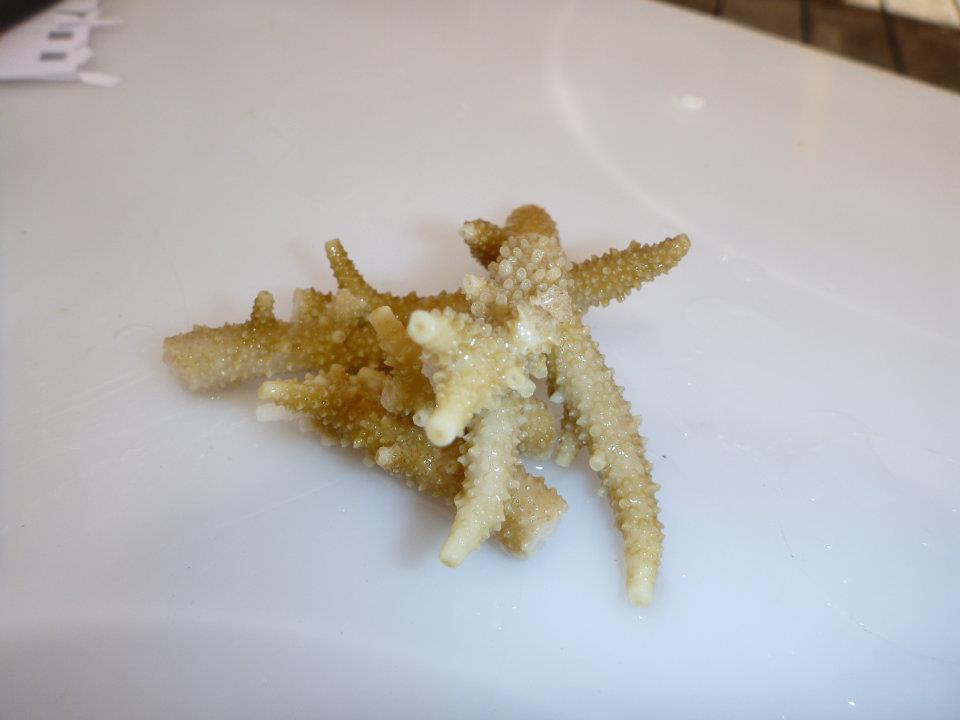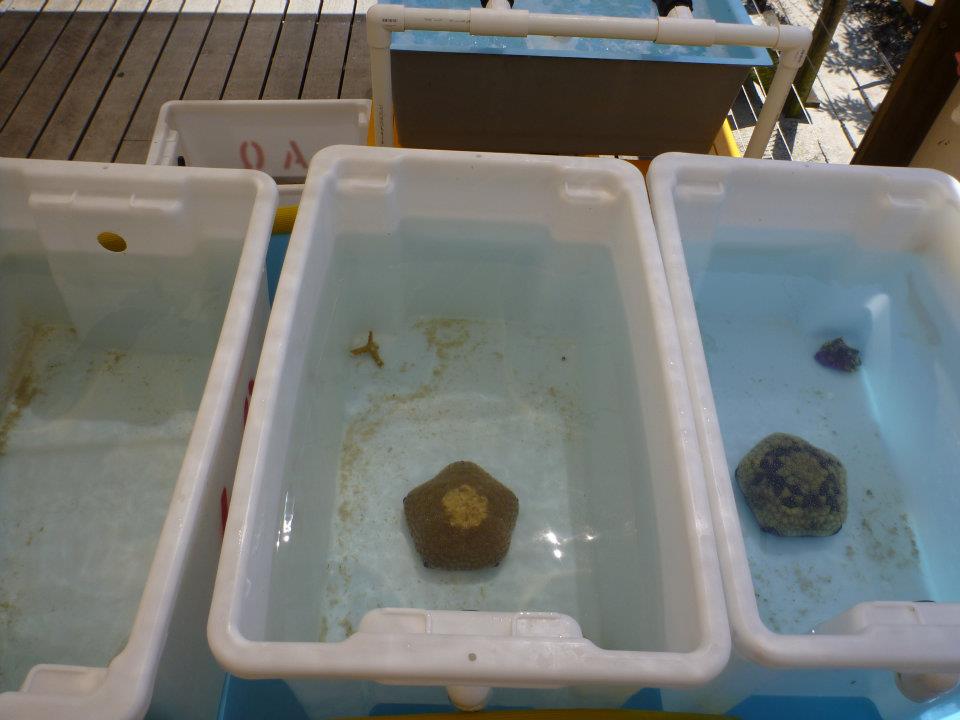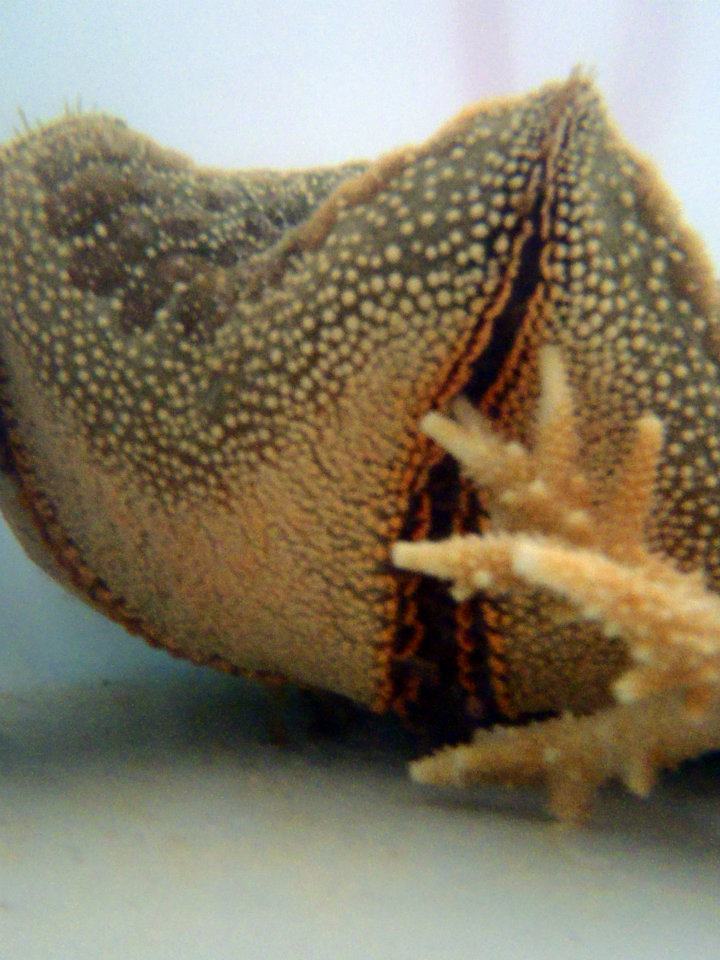Introduction
Asteroids are largely predators of large invertebrates and scavengers (Hickman et al. 2008). The early juvenile cushion star feeds on encrusting algae, especially crustose coralline algae and epibenthic diatoms. (Yamagutchi 1975).Adult Culcita novaguineae preys on coral polyps and also eats other small organisms and detritus (Yamagutchi 1977, Hickman et al. 2008). It predominantly feeds nocturnally, continuously moving in search for food (Hawkins 2006). Coral feeding is rather specialised as this species has a large biomass to support comparative to its stomach surface. Commonly preys on small or encrusting reef-building coral colonies because it lacks prehensile arms and cannot climb large or high corals. Usually selects small corals of low relief – Pocillopora, Acropora, Porites and faviids. Field observations suggest they favour Pocillpora spp. Can also prey on platelike and encrusting pavonid species in the Pacific (Krupp 1985).
Cushion stars feed with eversion of the stomach over the coral and digest the soft tissues in situ. Studies have shown this species can prey selectively on certain species of coral and may therefore be important in affecting the size structure and relative abundance of corals in coral reef communities (Krupp 1985).
Many studies have looked at the feeding preferences of this species (Krupp 1985, Hawkins 2006). Upon field observations by Krupp (1985), 67% of individuals were found feeding on corals, the other 33% found eating bryocoans, algae and sponges. (Krupp 1985). As this species is primarily a corallivore, most studies have looked at the preferences of coral species or types. This information aids in determining the sea stars' effect on the reef. Results have shown that cushion stars show a preference for
Pocillopora ( in particular P. damicornis) and Acropora spp. over Porites compressa, Montipora verrucosa and Fungaria scutaria. In French Polynesia Culcita novaeguineae is documented to settle near Porites spp. in areas where Porites corals are sparse, but prefers to feed on Acropora spp. Feeding rates on Pocilliopora damicornis is documented ~28cm² (250cm³)/day. (Krupp 1985, Hawkins 2006).
As cushion stars are documented as nocturnal feeders (Hawkins 2006), this study aimed to investigate if time of day had an effect on the feeding, and also coral preference, of this species.
Methods
The study was conducted at the University of Queensland Research Station on Heron Island.

Culcita novaeguineae was collected from the reef flat and reef crest directly outside of the research station. The six sea star specimens were then kept in flowing sea water tanks and fasted for four days. During this time the cushion stars were kept outside and exposed to a normal day/night light cycle. Coral specimens were collected from Shark Bay on Heron Reef, and held in a tank containing flowing sea water. Experimentation began at 9pm on the 22/09/2011. Cushion stars were kept in artificial light conditions following dusk. Three cushion stars were placed in the feeding experiment, while the other three were placed in the turning experiment. Following completion of the two experiments, the specimens were rotated to the adjacent experiment.
Feeding Experiment
The cushion star was placed in the middle of the tub. They were left for ten minutes to settle in their new environment before corals entered the water. In each corner of the tub a coral specimen was placed. Corals A, B and C (see figure below) were assigned randomly to corners, and one corner was left empty. The sea star was then observed for one hour. During this time it was documented if the sea star approached a coral, began to eat a coral, or remained still. The coral specimen first approached was documented. If the sea star remained still, coral preference was documented as None (N). If the sea star approached the empty corner of the tub, this was documented as Empty (E).
This process was carried out for each individual, both at night under artificial light, and during the day under natural light.

Feeding experiment set up.

 
CORAL A - Acropora spp. CORAL B - Poccilopora spp. CORAL C. Porites spp.

Example coral species arrangement.

The three feeding experiment tubs under natural light.
Turning Experiment
Cushion stars were placed in a circular tank, three specimens at a time, and given ten minutes to adjust to their new environment. The were then upturned onto their aboral side and timed to observe how long they took to turn. A complete turn was identified as having the oral side of all arms in contact with the surface. This experiment was conducted under both artificial light (night) and natural light (day) for each of the six specimens.
 
Turning experiment set up.
Weight
The specimens were all weighed using tubular spring scales, to the nearest 10 grams. Specimens were weighed immediately upon removal from the water to gain an approximate wet weight.
Results
Feeding Experiment
No cushion stars were found to be feeding on corals under either natural light (day) or artificial light (night). Some cushion stars however, did a approach a coral species. This was seen under both artificial and natural light. The sea stars appeared to have a preference for Acropora spp.. Three individuals approached Acropora spp., whereas only one approached Poccillopora spp., and none approached Porites spp.

A cushion star approaching Acropora spp.
ARTIFICAL LIGHT
|
Specimen
|
First Coral Preference
|
Time approached coral
|
Coral Eaten
|
|
1
|
None
|
N/A
|
No
|
|
2
|
Acropora
|
5 minutes
|
No
|
|
3
|
Acropora
|
10 minutes
|
No
|
|
4
|
Empty
|
N/A
|
No
|
|
5
|
Empty
|
N/A
|
No
|
|
6
|
Empty
|
N/A
|
No
|
NATURAL LIGHT
|
Specimen
|
First Coral Preference
|
Time approached coral
|
Coral Eaten
|
|
1
|
None
|
N/A
|
No
|
|
2
|
None
|
N/A
|
No
|
|
3
|
Pocillopora
|
17 minutes
|
No
|
|
4
|
None
|
N/A
|
No
|
|
5
|
None
|
N/A
|
No
|
|
6
|
Acropora
|
11 minutes
|
N
|
Turning Experiment
The average time taken for a sea star to turn over was slightly higher during the day under natural light (87 minutes) than at night under artificial light (69 minutes). However when looking at individual sea stars, there was no pattern of taking longer during either day or night. Some specimens took longer to turn at night, whereas others took longer to turn during the day.
ARTIFICIAL LIGHT
|
Specimen
|
Time Taken to Turn
|
|
1
|
2 hours 55 minutes
|
|
2
|
2 hours 40 minutes
|
|
3
|
14 minutes 50 seconds
|
|
4
|
4 minutes 10 seconds
|
|
5
|
55 minutes 12 seconds
|
|
6
|
6 minutes 29 seconds
|
NATURAL LIGHT
|
Specimen
|
Time Taken to Turn
|
|
1
|
11 minutes 02 seconds
|
|
2
|
2 hours 35 minutes
|
|
3
|
9 minutes 09 seconds
|
|
4
|
35 minutes 20 seconds
|
|
5
|
3 hours 25 minutes
|
|
6
|
4 minutes 52 seconds
|
Weight
Weight had no significant effect on the average turn time (combined day and night) for each individual (ANCOVA P=0.899).
|
Specimen
|
Weight (kg)
|
|
1
|
1.55
|
|
2
|
1.25
|
|
3
|
2
|
|
4
|
1.84
|
|
5
|
2.88
|
|
6
|
2.68
|
Conclusion
Culcita novaeguineae is a coral predator found all over the Indo-Pacific. This species is abundant on the reef of Heron Island.
During this experiment, the cushion stars showed no feeding behavior under light conditions. This result is peculiar as cushion stars in previous experiments have fed on the same species of coral after being fasted only 24 hours, whereas the sea stars in this experiment were fasted for four days before experimentation. This result is somewhat is indicative that cushion stars prefer to feed under dark conditions, and that their nocturnal feeding behavior is most likely not a result of circadian rhythms.
This species has exhibited a slight preference for the coral Acropora spp. over Poccilopora spp. and Porities spp. It is possible that this species prefers to feed on this coral, coherent with previous studies (Krupp 1985, Hawkins 2006). If this is the case, selective predation on Acropora spp. could potentially limit the abundance of this coral species on Heron Island. Changes in the abundance of this coral could then lead to an effect on the ecology of the reef and available habitat for other species including reef fish.
No significant effect of weight on turning time was seen. This indicates that that size did not play a role in the ability for a cushion star to turn over. Therefore, after being upturned, different sized adults will most likely have equal ability to turn back over. As there was no pattern of individual cushion stars' turn time under artificial or natural light, it is likely that their maneuverability is not effected by the day/night cycle. These results may be different under light and dark conditions, and there is room here for future investigation.
|